| کد مقاله | کد نشریه | سال انتشار | مقاله انگلیسی | نسخه تمام متن |
|---|---|---|---|---|
| 2601491 | 1562644 | 2008 | 7 صفحه PDF | دانلود رایگان |

Patulin (PAT) is a fungal secondary metabolite that exhibits potential cellular and animal toxicities. In this study, human promyelocytic leukemia (HL-60) cells were used to elucidate the mechanism and death mode associated with PAT. Morphological evidence of apoptosis, including membrane blebbing, nuclei fragmentation and DNA laddering formation was clearly observed 6 h after exposure to PAT. The results of Western blotting indicated that PAT activated various processed caspases, and cleaved DFF45 and poly (ADP-ribose) polymerase (PARP) in a dose-dependent manner; it also induced a time-dependent increase in caspase 3 and 9 catalytic activities.The apoptosis mediated by PAT in HL-60 was accompanied with cytochrome c release from mitochondria and Bcl-2 expression decrease. The presence of thiol-containing compounds with PAT dramatically reduced the caspase 3 activity that was triggered by PAT; the addition of antioxidants, including mannitol and Tiron, had a similar effect. However, the suppression of p53 protein expression by RNA interference (RNAi) in human embryonic kidney (HEK293) cells did not significantly modify PAT-elicited caspase 3 activity. These findings suggest that PAT-induced apoptosis is mediated through the mitochondrial pathway without the involvement of p53; the interaction with sulfhydryl groups of macromolecules by PAT and the subsequent generation of reactive oxygen species (ROS) plays a primary role in the apoptotic process.
Journal: Toxicology Letters - Volume 183, Issues 1–3, 15 December 2008, Pages 105–111